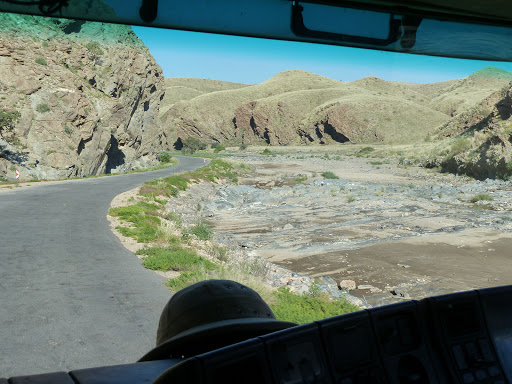And I thought Spitzkoppe had been spectacular.
As it turns out, Spitzkoppe, the surrounding plains and the Atlantic coast, impressive as they had all been, were simply the opening act for the stunning headliner that was the Namib desert around Sossusvlei and Dead Vlei.
After several days of R&R in Swakopmund, we'd left early and started south on our drive into the heart of the Namib desert. Even so early on in the journey (we were not to reach Sossusvlei until the following day) the landscapes were beautiful, and Jen and I decided to take them in from the front cab of the truck with Drew and Carol rather than sitting in the back as we had up until that point. There was also the obligatory photo stop as we crossed the Tropic of Capricorn (though having grown up an hour from the Tropic of Capricorn, I was slightly less impressed by this than everyone else...).
An evening of camping, combined with the rather beautiful experience of viewing moonrise while the sun set, was the perfect close to the day.
The main event of Sossusvlei, however, was the following day. And actually, the main event was a triple bill.
First up was Dune 45, the most accessible and most photographed of the massive red dunes in the Namib-Naukluft park - so named because it is 45km along the highway from Sesriem to Sossusvlei (NOT, as many people seem to believe, because it's the 45th dune in a sequence). The dune (and the plethora of dunes around it, for that matter) is tall, red and breathtaking, and made for an exhilarating pre-breakfast climb. In my writings on a previous travel odyssey I'd made the observation that the salt planes of Bolivia brought to my mind images of a lunar landscape. Well some of the views around the Namibian dunes took us even further off-world and really did make us think that we'd left the Earth and were now climbing around Mars. With oxygen, obviously.
Sossusvlei is the name generally given to this particular area of the Namib desert, but Sossusvlei itself is in fact a salt and clay pan set amidst the surrounding massive dunes, and is created by a river that flows through the Namib every few years. Sossusvlei means "dead end marsh" or "marsh of no return" and it's easy to see how the name came about with such stark and desolate surrounds, although we were lucky enough to see it just after a flood and so it contained lot more water than is usually to be found there.
However, it was the third part of the triple bill that was, for me, the absolute highlight of the Sossusvlei region - Dead Vlei. This is a truly remarkable place - the river that runs through Sossusvlei used to find its way here too, which is how the pan was formed, but now it is completely dead and absent of water, which makes for a stark and yet stunning spectacle. There isn't even enough moisture here for standard levels of decomposition to occur, meaning the long dead trees have been perfectly preserved. Surrounded by dunes over 300m high, it's truly like you've reached the ends of the earth, a surreal dream, or at the very least a photo shoot for The Joshua Tree.
It really is the kind of place that needs to be seen to be appreciated, and believed. The above pics, great as they are, still don't really do it justice.
Namibia is an absolutely stunning country - it terms of the sheer, stark, yet breathtaking beauty of its landscapes, I think I would rank it alongside Bolivia and behind only Antarctica in my personal travel experience. Our time here is running out, and I already know I'll be coming back. Such a place demands multiple visits, and extensive exploration.
Things Jennie will Remember:
1) Spotting the monitor lizard crossing the road
2) Seeing a rock hyrax sitting on the rocks as we drove through the Naukluft Mountains. Interestingly, the closest living relative of the tiny rock hyrax is the elephant!
Here are the photos:


















No comments:
Post a Comment